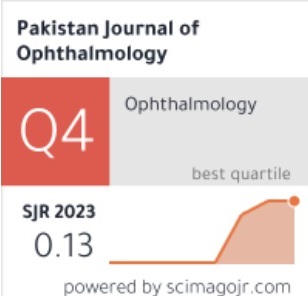Demographic Characteristics and Causes of Acquired Non-senile Ptosis: Experience at a Tertiary Oculoplastic Center
http://doi.org/10.36351/pjo.v37i2.1173
DOI:
https://doi.org/10.36351/pjo.v37i2.1173Keywords:
Blepharoptosis, Third nerve palsy, Myasthenia gravis.Abstract
Purpose: To determine the demographic characteristics and causes of acquired, non-senile ptosis in patients presenting to an oculoplastic clinic of a tertiary care centre.
Study Design: Observational case series.
Place and Duration of Study: Lady Reading Hospital, from January 2016 to December 2017.
Methods: Twenty eight patients were fulfilling the inclusion criteria were recruited in the study. Detailed history with complete examination and investigations like electromyography, acetylcholine receptor antibody test and CT/MRI brain were performed when required. Cause of each ptosis was determined and the relative proportions were calculated.
Results: There were 28 cases with acquired, non-senile ptosis. Fifty seven percent were males while females were 42.9%. Patients were divided into four age groups. Most of the patients were in age group of 42–62 years. Eyelid/orbit tumor and Chronic progressive external ophthalmoplegia (CPEO) was seen in 3.6% and 7.1% patients of < 20 years of age respectively. Myasthenia gravis and thyroid related pseudoptosis was common in patients of 21-41 years. In patients with age 42-62 years, Pseudoptosis due to thyroid disorder was the commonest. In patients with age more than 63 years, 3rd nerve palsy, eyelid/orbital mass and Myasthenia gravis was seen. Third nerve palsy and Pseudoptosis secondary to thyroid and eyelid/orbit mass were more common in males while Myasthenia gravis was more common in females. CPEO was equally seen in both genders with
p = 0.575.
Conclusion: Thyroid related eyelid pseudoptosis of the contralateral eye was the commonest cause in this case series.
Key Words: Blepharoptosis, Third nerve palsy, Myasthenia gravis.






